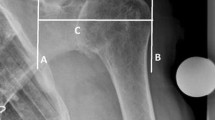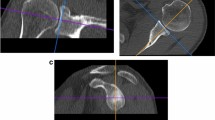Abstract
Purpose
The correct amount of arm lengthening in reverse shoulder arthroplasty is crucial to provide joint stability and good results. Determination has been proposed according to radiographs. However, radiographic measurements are error prone in regards to positioning of the arm with regard to the radiographic beam. The purpose of this study was to evaluate the precision of radiographic measurements compared to CT scans of the upper limb following reverse shoulder arthroplasty.
Methods
Thirty patients undergoing onlay reverse shoulder arthroplasty with comparative radiographs and CT scans of both humeri were included in this study. Arm length, humeral length as well as the arm and humeral lengthening were evaluated on pre- and postoperative radiographs compared to postoperative CT scans following a previously validated protocol.
Results
We found an excellent correlation for arm length and humeral length for radiographic and CT measurements (r > 0.90). The postoperative humeral and arm lengthening compared to the contralateral side was 0.1 (−1.2 to 1.2) cm and 2.8 (0.2 to 5.2) cm for the CT scans, and −0.6 (−4.1 to 2.0) cm and 1.9 (−2.3 to 5.0) cm for the radiographs. For arm lengthening, correlation coefficient was good (r = 0.7) even though radiographs indicated arm shortening in five cases whereas arm lengthening was observed on CT scans.
Conclusions
Measurements on radiographs and CT scans are comparable in most of the cases. However, we observed some important variations that question the reliability of radiographic measurements in up to 20 % of cases. Therefore, a CT scan appears to be necessary in the event of postoperative complications (e.g., instability, neurological problems).


Similar content being viewed by others
References
Favard L, Levigne C, Nerot C, Gerber C, De Wilde L, Mole D (2011) Reverse prostheses in arthropathies with cuff tear: are survivorship and function maintained over time? Clin Orthop Relat Res 469(9):2469–2475. doi:10.1007/s11999-011-1833-y
Sirveaux F, Favard L, Oudet D, Huquet D, Walch G, Molé D (2004) Grammont inverted total shoulder arthroplasty in the treatment of glenohumeral osteoarthritis with massive rupture of the cuff. Results of a multicentre study of 80 shoulders. J Bone Joint Surg Br 86:388–395
Wall B, Nove-Josserand L, O’Connor DP, Edwards TB, Walch G (2007) Reverse total shoulder arthroplasty: a review of results according to etiology. J Bone Joint Surg Am 89:1476–1485. doi:10.2106/JBJS.F.00666
Terrier A, Reist A, Merlini F, Farron A (2008) Simulated joint and muscle forces in reversed and anatomic shoulder prostheses. J Bone Joint Surg (Br) 90-B:751–759. doi:10.1302/0301-620X.90B6.19708
Boileau P, Watkinson D, Hatzidakis AM, Balg F (2005) Grammont reverse prosthesis: design, rationale and biomechanics. J Should Elb Surg 14(1 Suppl S):147S–161S
Lädermann A, Williams MD, Melis B, Hoffmeyer P, Walch G (2009) Objective evaluation of lengthening in reverse shoulder arthroplasty. J Should Elb Surg 18:588–595. doi:10.1016/j.jse.2009.03.012
Lädermann A, Lubbeke A, Melis B, Stern R, Christofilopoulos P, Bacle G, Walch G (2011) Prevalence of neurologic lesions after total shoulder arthroplasty. J Bone Joint Surg Am 93:1288–1293. doi:10.2106/ JBJS.J.00369
Boileau P, Watkinson D, Hatzidakis AM, Hovorka I (2006) Neer Award 2005: the Grammont reverse shoulder prosthesis: results in cuff tear arthritis, fracture sequelae, and revision arthroplasty. J Should Elb Surg 15:527–540. doi:10.1016/j.jse.2006.01.003
Renaud P, Wahab H, Bontoux L, Dauty M, Richard I, Bregeon C (2001) Total inverted shoulder prosthesis and rotator cuff insufficiency: evaluation and determination of anatomical parameters predictive of good functional outcome in 21 shoulders. Ann Readapt Med Phys 44(5):273–80
Werner CM, Steinmann PA, Gilbart M, Gerber C (2005) Treatment of painful pseudoparesis due to irreparable rotator cuff dysfunction with the Delta III reverse-ball-and-socket total shoulder prosthesis. J Bone Joint Surg Am 87:1476–1486. doi:10.2106/JBJS.D.02342
Favard L, Alami G, Young A, Dezaly C, Falaise V (2010) Long-term outcomes with the reverse shoulder prosthesis: 10 to 15 years of follow-up. In: Walch et al. (eds) Shoulder Concepts 2010. The Glenoid. Sauramps Medical, Montpellier, pp 421–466
Guery J, Favard L, Sirveaux F, Oudet D, Mole D, Walch G (2006) Reverse total shoulder arthroplasty. Survivorship analysis of eighty replacements followed for five to ten years. J Bone Joint Surg Am 88:1742–1747
Lädermann A, Edwards TB, Walch G (2014) Arm lengthening after reverse shoulder arthroplasty: a review. Int Orthop 38(5):991–1000. doi:10.1007/s00264-013-2175-z
Grammont PM, Trouilloud P, Laffay JP, Deries X (1987) Study and development of a new shoulder prosthesis [in French]. Rhumatologie 39:407–418
Valenti P, Katz D (2005) Comment implanter une prothèse d’épaule inversée? In: Maîtrise Orthopédique N°148
Werner BS, Böhm D, Gohlke F (2013) Revision to reverse shoulder arthroplasty with retention of the humeral component. Acta Orthop 84(5):473–478. doi:10.3109/17453674.2013.842433
Jobin CM, Brown GD, Bahu MJ, Gardner TR, Bigliani LU, Levine WN, Ahmad CS (2012) Reverse total shoulder arthroplasty for cuff tear arthropathy: the clinical effect of deltoid lengthening and centre of rotation medialization. J Should Elb Surg 21(10):1269–1277. doi:10.1016/j.jse.2011.08.049
Greiner SH, Back DA, Herrmann S, Perka C, Asbach P (2010) Degenerative changes of the deltoid muscle have impact on clinical outcome after reversed total shoulder arthroplasty. Arch Orthop Trauma Surg 130(2):177–183. doi:10.1007/s00402-009-1001-y
Lädermann A, Walch G, Lubbeke A, Drake GN, Melis B, Bacle G, Collin P, Edwards TB, Sirveaux F (2012) Influence of arm lengthening in reverse shoulder arthroplasty. J Should Elb Surg 21:336–341. doi:10.1016/j.jse.2011.04.020
Conflict of interest
Dr. Gilles Walch receives royalties from Tornier Company.
Ethical approval
All procedures performed in studies involving human participants were in accordance with the ethical standards of the institutional and/or national research committee and with the 1964 Helsinki Declaration and its later amendments or comparable ethical standards.
Author information
Authors and Affiliations
Corresponding author
Rights and permissions
About this article
Cite this article
Werner, B.S., Daggett, M., Carrillon, Y. et al. Evaluation of lengthening in reverse shoulder arthroplasty comparing X-rays and computerised tomography. International Orthopaedics (SICOT) 39, 2389–2394 (2015). https://doi.org/10.1007/s00264-015-2780-0
Received:
Accepted:
Published:
Issue Date:
DOI: https://doi.org/10.1007/s00264-015-2780-0




